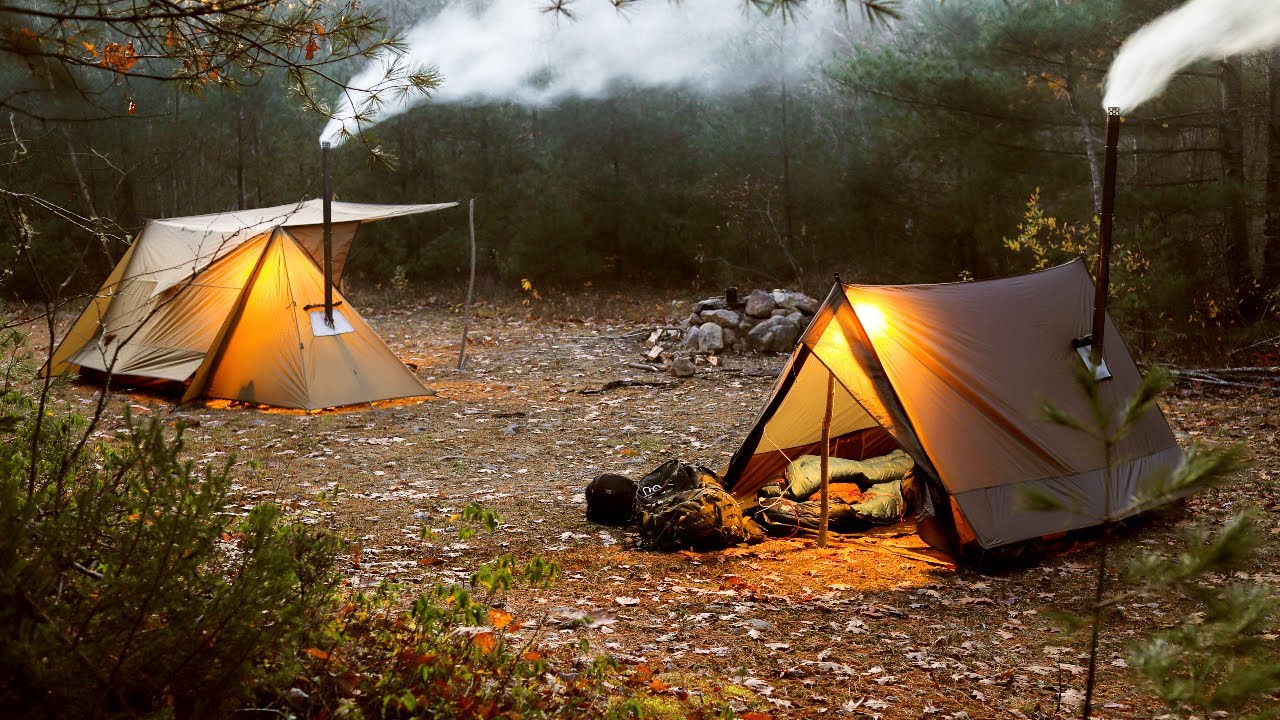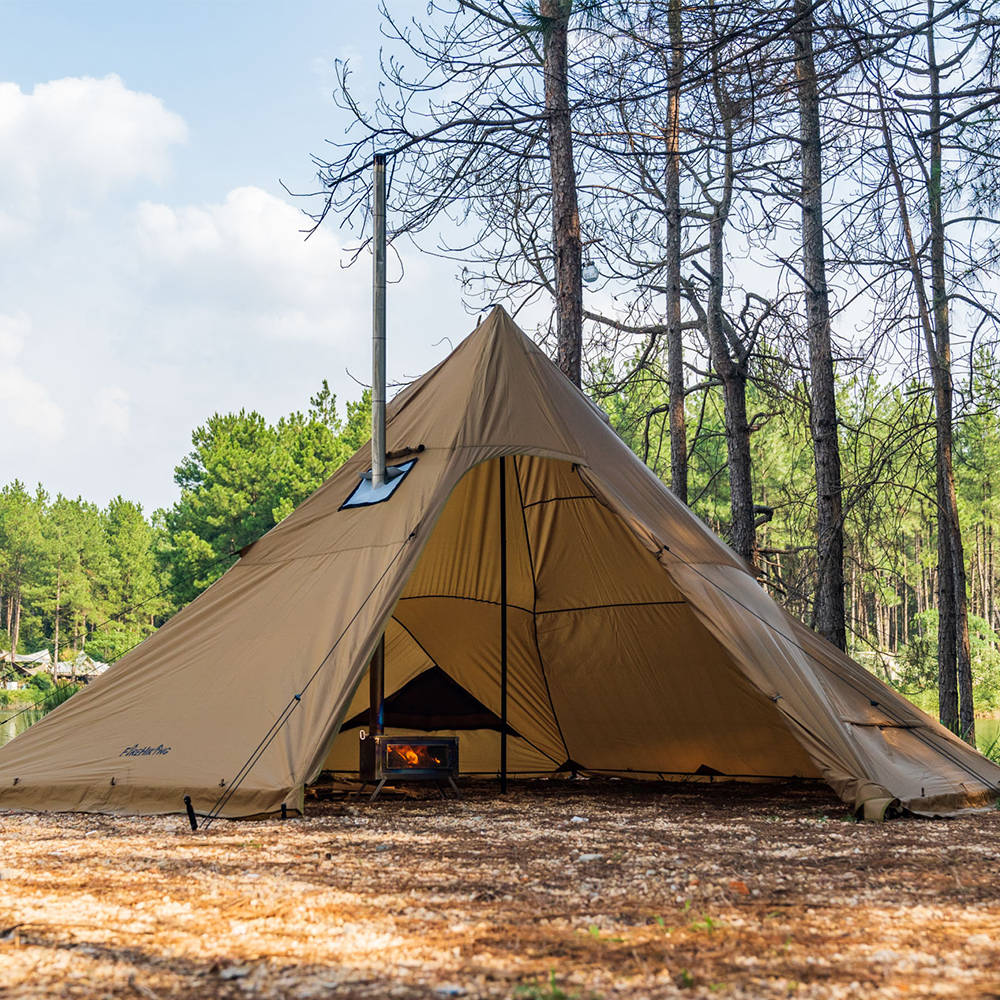Ultimate Guide to Choosing the Perfect Hot Tent for Your Camping Adventure
Introduction:
1. Understanding Hot Tents:
What is a hot tent?
A hot tent is a type of tent specifically designed for camping in cold weather conditions. Unlike regular tents, hot tents are equipped with a stove jack, which is a specially designed opening that allows for the safe use of a wood-burning stove or heater inside the tent. The stove is used to provide heat, warmth, and cooking capabilities, making hot tent camping a comfortable and cozy experience even in freezing temperatures.
How does a hot tent work?
- Setting up the Tent: Hot tents are designed with a stove jack, which is a specially designed opening that allows the stovepipe to pass through the tent. The stove jack is often reinforced with fire-resistant fabric or metal rings to prevent heat damage.
- Assembling the Stove: A wood-burning stove or heater is placed inside the tent, near the stove jack. The stove is typically made of metal, with a firebox for burning wood or other combustible materials, and a chimney or stovepipe for venting smoke and gases outside the tent.
- Airflow and Ventilation: Proper airflow and ventilation are important for safety and comfort. Hot tents usually have vents, windows, or adjustable flaps that can be opened or closed to regulate airflow and manage condensation. This helps maintain a fresh air supply and prevents the buildup of carbon monoxide.
- Starting the Fire: To generate heat, wood or other suitable fuel is burned in the stove's firebox. The fire creates radiant heat, which warms the surrounding area inside the tent.
- Heat Distribution: The stovepipe connected to the stove extends through the stove jack and exits the tent. As the fire burns, the stovepipe carries the smoke and hot gases outside the tent, while also distributing heat throughout the tent. The stovepipe's length and design help to maximize heat dispersion.
- Insulation and Heat Retention: Hot tents are typically made from materials that provide insulation and retain heat. The tent's fabric and construction help trap the warm air generated by the stove inside the tent, preventing it from escaping and keeping the interior warm and comfortable.
- Cooking and Warmth: The heat generated by the stove can be used for multiple purposes. It provides warmth and comfort, making the interior of the tent a cozy space to relax, sleep, and socialize. Additionally, many hot tents have cooking capabilities, allowing campers to prepare meals and boil water using the stove's heat.
- Benefits of using a hot tent for camping.
- Using a hot tent for camping offers several streamlined benefits, especially in cold weather conditions:
- Warmth and Comfort: Hot tents provide a cozy living space, keeping you warm and comfortable in cold temperatures.
- Extended Camping Season: With a hot tent, you can camp in colder months, extending your outdoor adventures throughout the year.
- Safe Heating: Hot tents are designed with safety in mind, ensuring proper ventilation and minimizing fire hazards.
- Convenient Cooking: Many hot tents have cooking capabilities, allowing you to prepare meals inside the tent without battling the elements.
- Versatility: Hot tents come in various sizes and designs to accommodate different group sizes and preferences.
- Reduced Condensation: Hot tents are designed to manage condensation effectively, keeping the interior dry and comfortable.
- Cozy Atmosphere: Hot tent camping creates a charming ambiance with the warmth and crackling sound of the stove.
- Overall, hot tents provide a practical and enjoyable solution for camping in cold weather, enhancing your camping experience and allowing you to appreciate nature in any season.
2. Factors to Consider When Choosing a Hot Tent:
-Tent size and capacity: Determining the right size for your group.
- Number of Campers: The first consideration is the number of people who will be sharing the tent. Most tents are labeled with their capacity, indicating the maximum number of people that can comfortably sleep inside. Consider the size and sleeping arrangements of your group to ensure everyone has enough space.
- Gear Storage: In addition to accommodating the sleeping campers, you'll need to account for gear storage space. Depending on the length of your trip and the amount of equipment you'll bring, you may need extra space inside the tent for storing backpacks, clothing, and other camping essentials.
- Comfort and Livability: Consider the comfort and livability factor of the tent. If you prefer more space to move around, sit up, and change clothes, you might want to choose a larger tent than the minimum required for your group size. Keep in mind that larger tents are often heavier and bulkier to transport.
- Season and Weather Conditions: The season and weather conditions you'll be camping in can impact your choice of tent size. In colder weather, you may want extra space to store gear and provide room for changing clothes. In warmer weather, a smaller and more streamlined tent may be sufficient.
- Additional Features: Some tents offer additional features like vestibules or awnings that provide extra covered space outside the main sleeping area. These features can be beneficial for storing gear, cooking, or providing a sheltered area to relax.
Tent materials and durability: Which materials are suitable for different weather conditions?
- Polyester: Polyester is a popular tent material known for its durability, water resistance, and UV resistance. It performs well in mild to moderate weather conditions and provides good protection against light rain and sun exposure. However, it may not be as effective in heavy rain or strong winds.
- Nylon: Nylon is another commonly used tent material. It is lightweight, durable, and provides good resistance against tearing. Nylon tents are often coated with a waterproof treatment to enhance their water resistance. They are suitable for a wide range of weather conditions, including light to moderate rain and wind.
- Ripstop Nylon: Ripstop nylon is a reinforced version of nylon that has a grid pattern of thicker threads woven into the fabric. This makes it more resistant to tearing and ripping. Ripstop nylon tents are suitable for various weather conditions and provide better durability in rugged environments.
- Canvas/Cotton: Canvas or cotton tents are known for their durability and breathability. They are heavier compared to synthetic materials but perform well in diverse weather conditions. Canvas tents are highly breathable, allowing for better airflow and reducing condensation. They are suitable for both hot and cold weather, offering insulation in colder temperatures and staying cool in warmer conditions. Canvas tents are also more resistant to strong winds.
- Poly/Cotton Blends: Poly/cotton blends combine the durability of synthetic materials with the breathability of natural fibers. They offer a good balance between strength, water resistance, and breathability. Poly/cotton tents provide versatility and are suitable for a wide range of weather conditions.
- Four-Season Tents: If you plan to camp in extreme weather conditions, such as heavy snow or high winds, consider a four-season tent. These tents are designed to withstand harsh weather, with stronger poles, reinforced fabrics, and enhanced stability. Four-season tents often use durable materials like ripstop nylon or polyester with high denier ratings for added strength.
Weight and portability: Finding the right balance between comfort and ease of transportation.
3. Types of Hot Tents:
4. Recommended Hot Tents from FireHiking:
- LEVA Series: Overview of features and benefits.
The LEVA Series offered by FireHiking consists of hot tents designed primarily in the teepee tent style, which provides excellent wind resistance, pressure resistance, and a high space-to-weight ratio. These hot tents are constructed using high-strength, waterproof, and heat-resistant fabrics, ensuring durability and protection in various weather conditions. The tents are supported by high-toughness aluminum tent poles, which further enhance their stability. The LEVA Series tents come with a stove jack and a half-inner tent, allowing for the installation of a tent stove separate from the sleeping area. This setup provides warmth and cooking capabilities while maintaining a comfortable sleeping space. FireHiking also offers other series of hot tents such as Firefort, Fireden, and Fireyurt. To complement the hot tents, FireHiking recommends their titanium stove, known for its lightweight design, strength, and efficient heat dissipation. Overall, the LEVA Series provides campers with reliable, weather-resistant hot tents and accessories for a comfortable outdoor experience.
- Firefort Series: Highlighting key characteristics.
The Firefort Series by FireHiking is specifically designed to cater to the needs of backpacker campers, prioritizing portability and easy storage. These hot tents excel in maintaining exceptional waterproofing and heat insulation performance while offering breathability. With the inclusion of a stove jack and inner tent, the Firefort Series allows for a clear separation between the sleeping area and the stove, ensuring safety and convenience. Perfect for hiking, fishing, and hunting, these hot tents serve as reliable fortresses for adventurous backpackers. Designed for 1-2 people, they are well-suited for all-weather camping. Alongside the Firefort Series, FireHiking also offers other hot tent series such as LEVA, Fireden, and Fireyurt. To complete your camping setup, FireHiking recommends their lightweight and high-performance titanium stove, which provides both warmth and cooking capabilities. With the Firefort Series hot tents and accompanying accessories, backpackers can enjoy a comfortable and enjoyable camping experience.
- Fireden Series: Perfect for solo or two-person camping.
The Fireden Series by FireHiking offers hot tents that are perfect for solo or two-person camping. These hot tents are renowned for their ultra-high water resistance, ensuring you stay dry even in challenging weather conditions. The Fireden Series also features an oversized stove jack, allowing for the safe and efficient use of a tent stove. These hot tents are designed to be portable and suitable for all-weather camping. Alongside the Fireden Series, FireHiking provides other series of hot tents such as LEVA, Firefort, and Fireyurt to cater to different camping needs. To complete your camping setup, FireHiking recommends their lightweight and high-performance titanium stove, which offers excellent heat dissipation and strength. Whether you're camping alone or with a companion, the Fireden Series hot tents offer reliability and comfort for your outdoor adventures.
- Fireyurt Series: Exploring the unique yurt tent design.
The Fireyurt Series by FireHiking introduces yurt tents designed specifically for all-season camping. These yurt tents are optimized versions of traditional yurts, making them suitable for backpacking, hunting, and family camping adventures. The unique yurt design offers a spacious and open interior, enhanced stability, and easy setup. The circular shape of the tent maximizes the available floor area, providing ample space for sleeping, lounging, and storing camping gear. The sturdy frames and durable materials ensure reliable shelter, even in challenging weather conditions. The collapsible frames make these tents convenient to set up and pack away, enhancing their portability. Ventilation features are incorporated to promote airflow and reduce condensation, ensuring a comfortable camping experience.
5. Hot Tent Accessories:
6. Tips for Hot Tent Camping:
Conclusion:
- More FireHiking Hot Tent Camping Gear
- Company Infomation
- About us
- FireHiking Story
- Contact Us
- Notice
- Blog
- Company Policies
- Payment Policy
- Return&Refund Policy
- Shipping Policy
- Privacy Policy
- Intellectual Property Rights
- Become Affiliate
- Terms Of Use
- Terms of Use
- User Center
- Forget Password
- My Orders
- Tracking Order
- My Account
- Register




